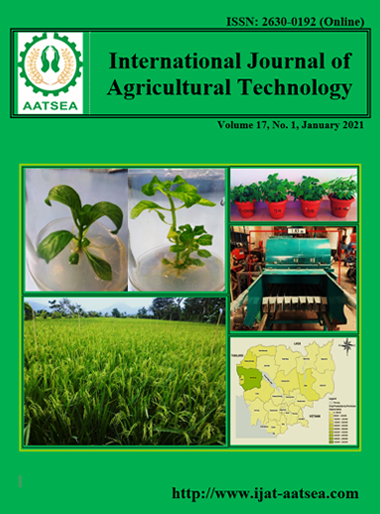Agricultural digitalization and rural development in COVID-19 response plans: A review article
Main Article Content
Abstract
COVID-19 has led to spread economic adversity throughout the world since it effects on food security. After COVID-19 there is necessary to suggest the novel direction and combination of new input, information and telecommunication technologies for agricultural growth and development. Agricultural digitalization is able to impact rapidly to mitigate some of the negative effect of the COVID-19 pandemic. In developing countries, rural information and services are the most important of effective agricultural and development. The "Internet of Things" and electronic networks offer very promising technologies and many services and solutions including the agricultural fields. The application of digital technology is of great importance because it has the ability to provide technologies, innovations and acquired sustainability to the agricultural sector and increase productivity as an alternative and complement to agricultural extension. Mobile application have developed rapidly for enhancing telecommunication, information ,input , development , invention in service transmission and their quality. However, many stakeholders have known the need for digital agriculture. The most countries have already taken a national strategy for the agricultural sector's use of information and communication technologies. These reviews explain the possibility of agricultural digitalization for rural services and development in COVID-19 response plans
Article Details

This work is licensed under a Creative Commons Attribution-NonCommercial-NoDerivatives 4.0 International License.
References
Abouziena, H. F. and Haggag, W. M. (2016). Weed control in clean agriculture: a review. Métodos Alternativos de Controle não Químicos de Plantas Daninhas: Uma Revisão Planta daninha, 34:377-392.
Baumüller, H. (2015). Assessing the role of mobile phones in offering price information and market linkages: the case of m-farm in Kenya, The Electronic Journal of Information Systems in Developing Countries, 68:1-16.
Brugger, F. (2011). Mobile Applications in Agriculture, Syngenta Foundation, mAgriculture.
Davis, K. (2008). Extension in sub-Saharan Africa: overview and assessment of past and current models and future prospects, Journal of International Agricultural and Extension Education, 15:15-28.
Elkholy, M. M., Mostafa, M., Ebeid, H. M. and Tolba, M. F. (2020). Application of Hyperspectral Image Unmixing for Internet of Things. In Internet of Things—Applications and Future, Springer, Singapore, pp. 249-260.
European Parliament (2015). Industry 4.0: Digitalisaton for productivity and growth. Brussels: European Parliamentary Research Service.
Fakhoury, R. (2018). Digital government isn’t working in the developing world. Here’s why. The Conversation. Retrieved from https://theconversation.com/digital-government-isntworking-in-the-developing-world-heres-why-94737).
FAO (2017). Information and Communication Technology (ICT) in Agriculture: A Report to the G20 Agricultural Deputies. Rome: FAO.
FAO (2018). The State of Food Security and Nutrition in the World: Building Resilience for Peace and Food Security. Rome: FAO. Retrieved from http://www.fao.org/news/story/ en/item/1152031/icode/).
Feder, G., Birner, R. and Anderson, J. R. (2011). The private sector's role in agricultural extension systems: potential and limitations, Journal of Agribusiness in Developing and Emerging Economies, 1:31-54.
Haggag, W. M., Tawfik, M. M., Abouziena, H. F., Abd El Wahed, M. S. A. and Ali, R. R. (2017). Enhancing Wheat Production under Arid Climate Stresses using Bio-elicitors. pringer: Springer Nature ; Gesunde Pflanzen, 69:149-158.
Haggag, W. M. and Fawzy, ZF. (2020). Information System (IS) for the Management of Pests, Diseases. Agricultural Studies, 4.
ITU and FAO (2020). Status of Digital Agriculture in 18 countries of Europe and Central Asia. International Telecommunication Union Telecommunication Development Bureau Place des Nations CH-1211 Geneva 20 Switzerland. Retrieved from https://www.itu.int/en/ITU-D/Regional Presence/Europe/Documents/Events/2020/
Kumar, A. and Karthikeyan, C. (2019). Status of mobile agricultural apps in the global mobile ecosystem. International Journal of Education and Development using Information and Communication Technology, 15:63-74.
Payne, G. T., Moore, C. B., Stanley, E. and Griffis, S. E. (2011). Multilevel Challenges and Opportunities in Social Capital Research Journal of Management, 37:491-520.
Woodill, G. and Udell, C. (2012). Agriculture, The application of mobile computing to the business of farming, Report by Float Mobile Learning.
World Bank (2012). Mobile application for agriculture and rural development. Washington, D.C.: World Bank Group. Retrieved from http://documents.worldbank.org/curated/en/ 167301467999716265/Mobile-.


